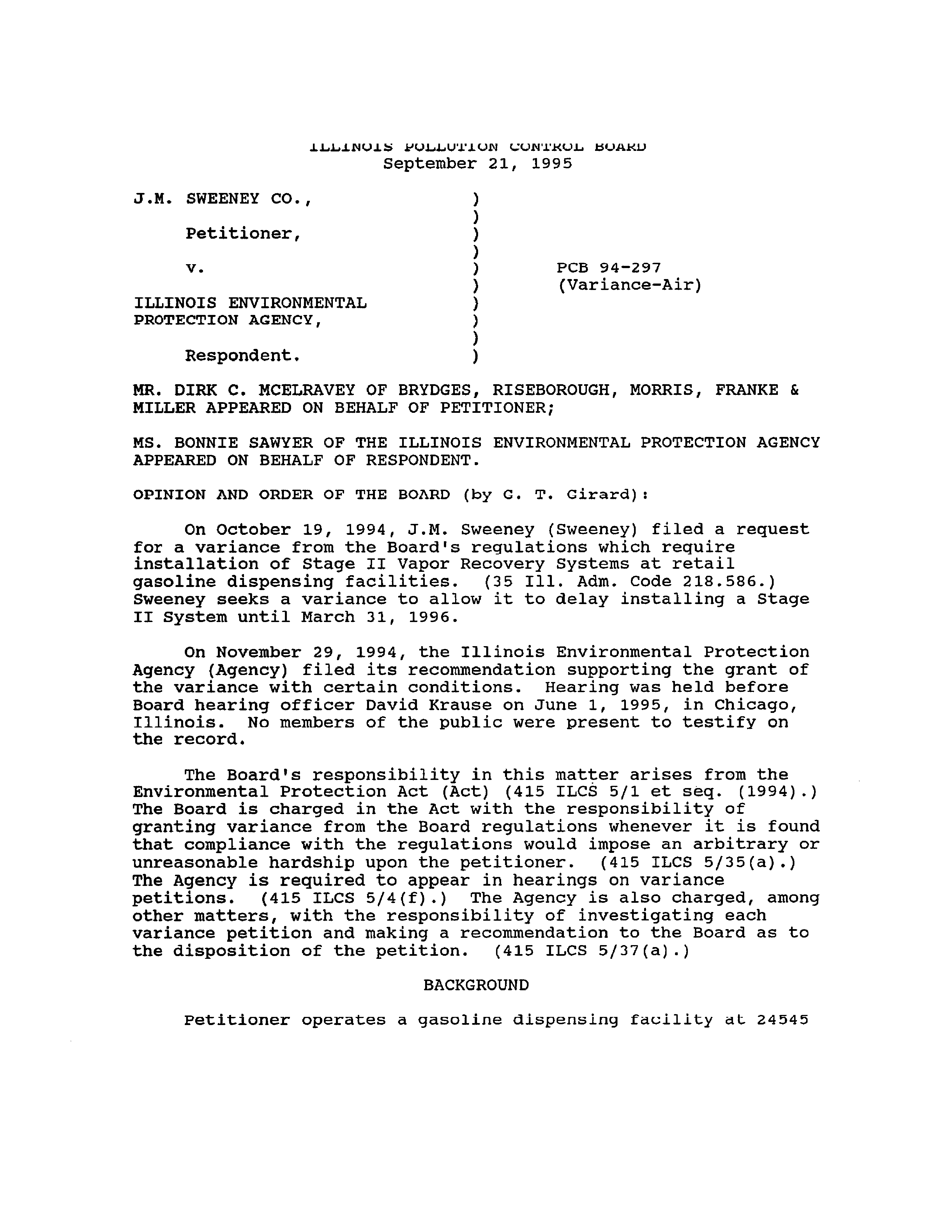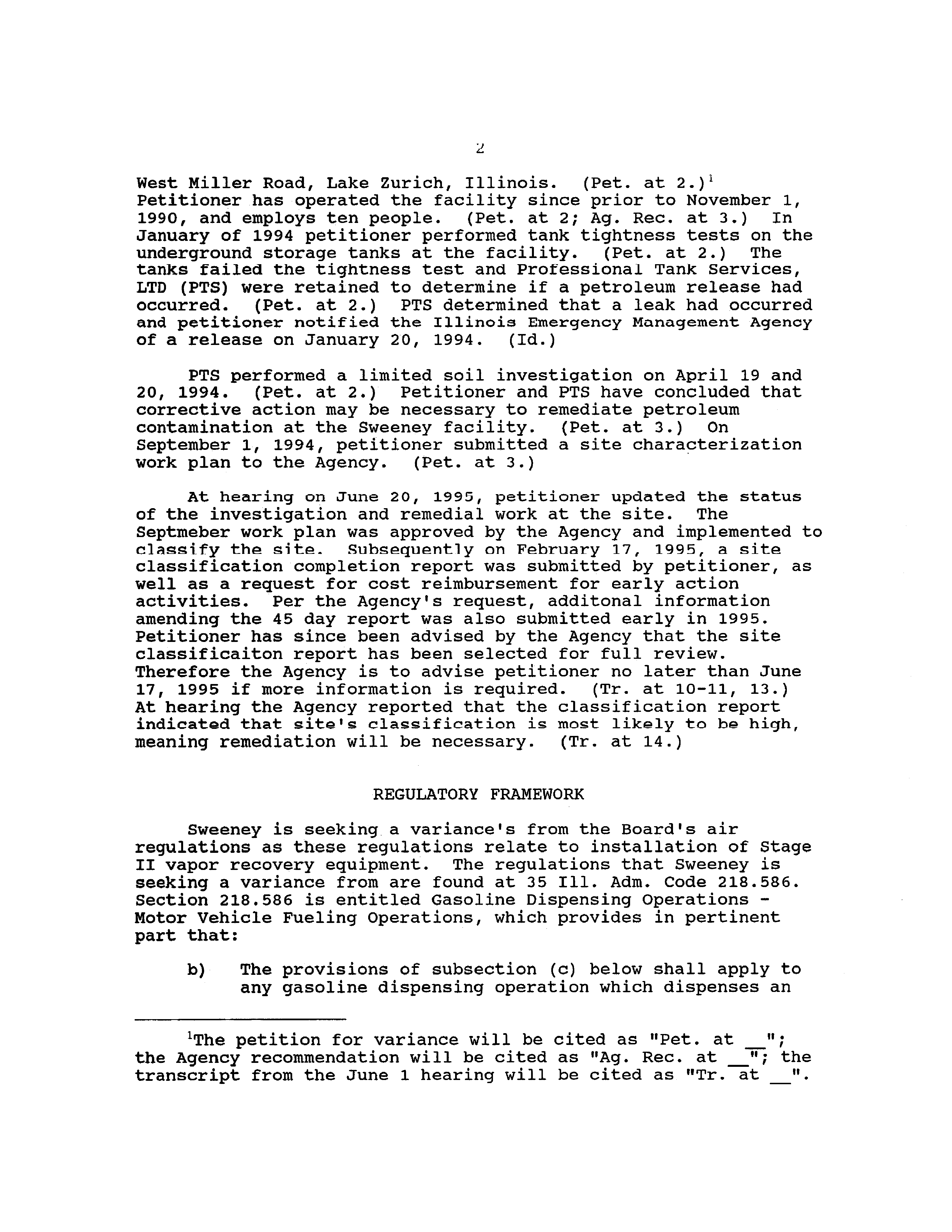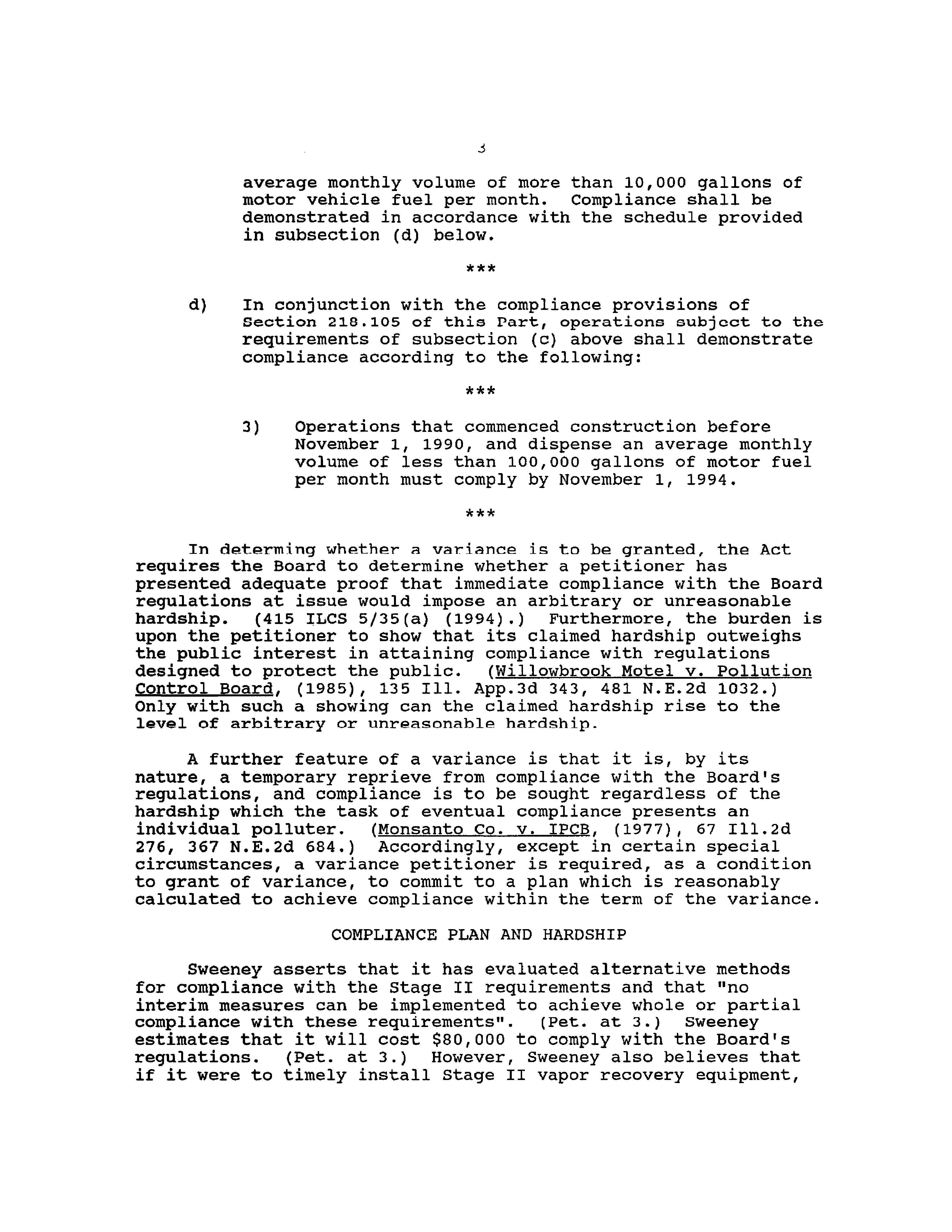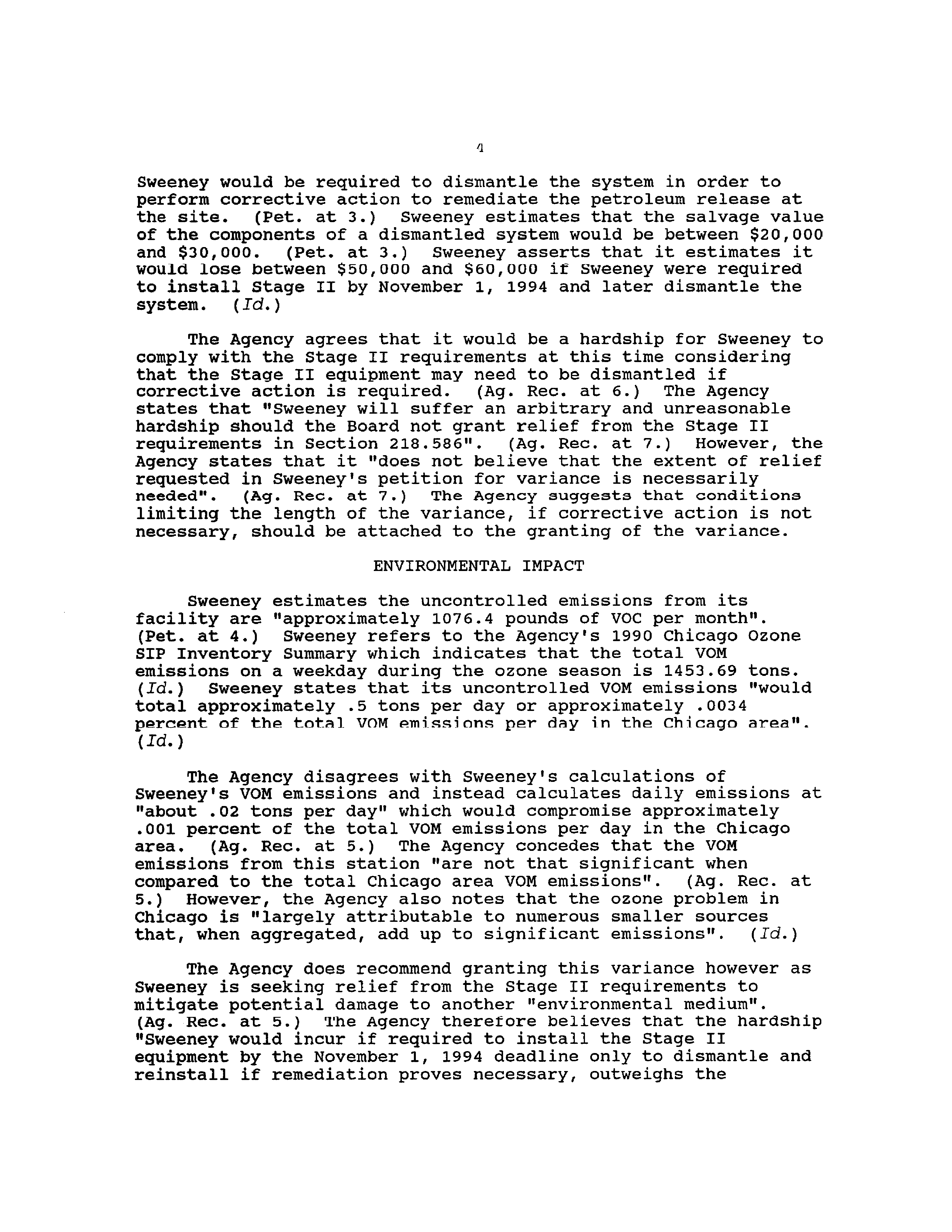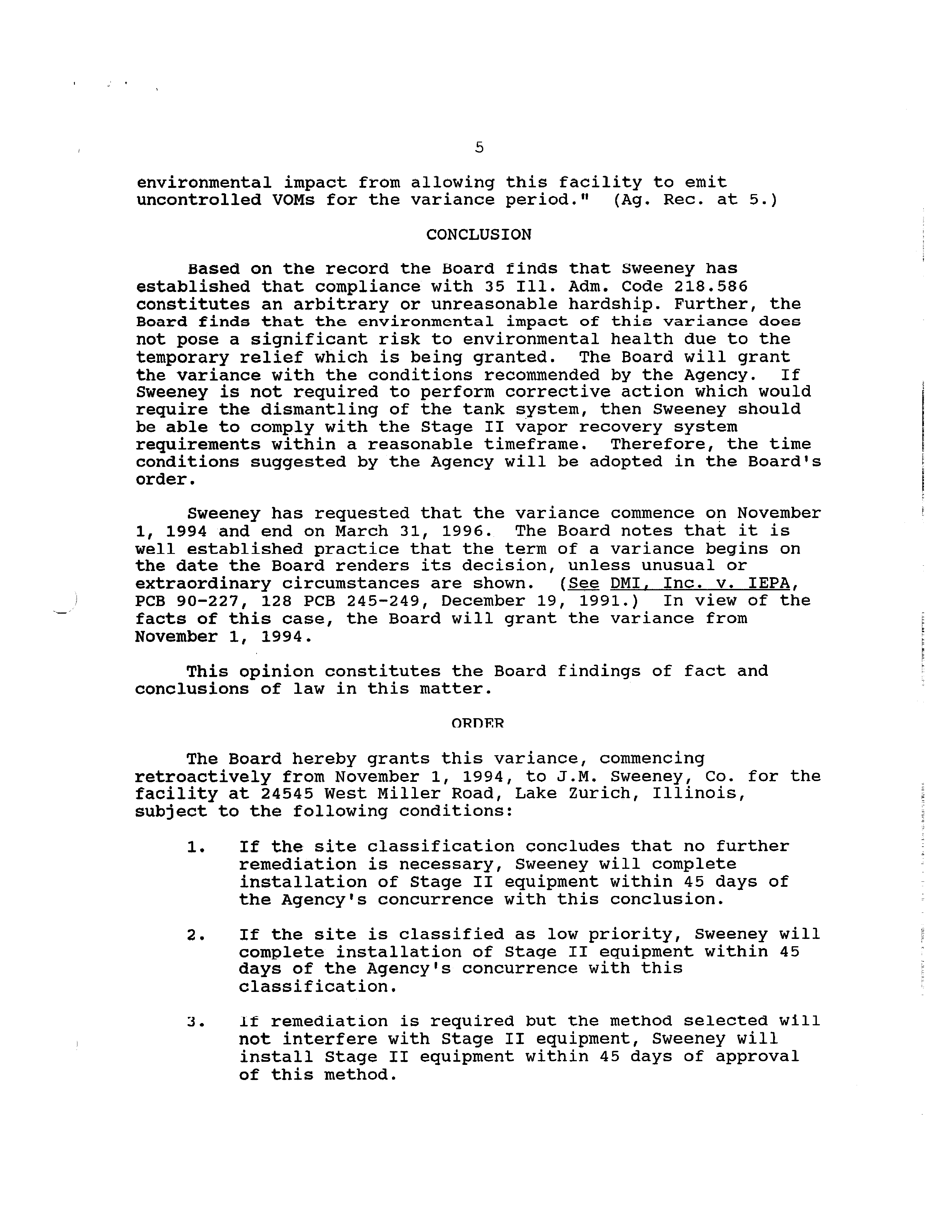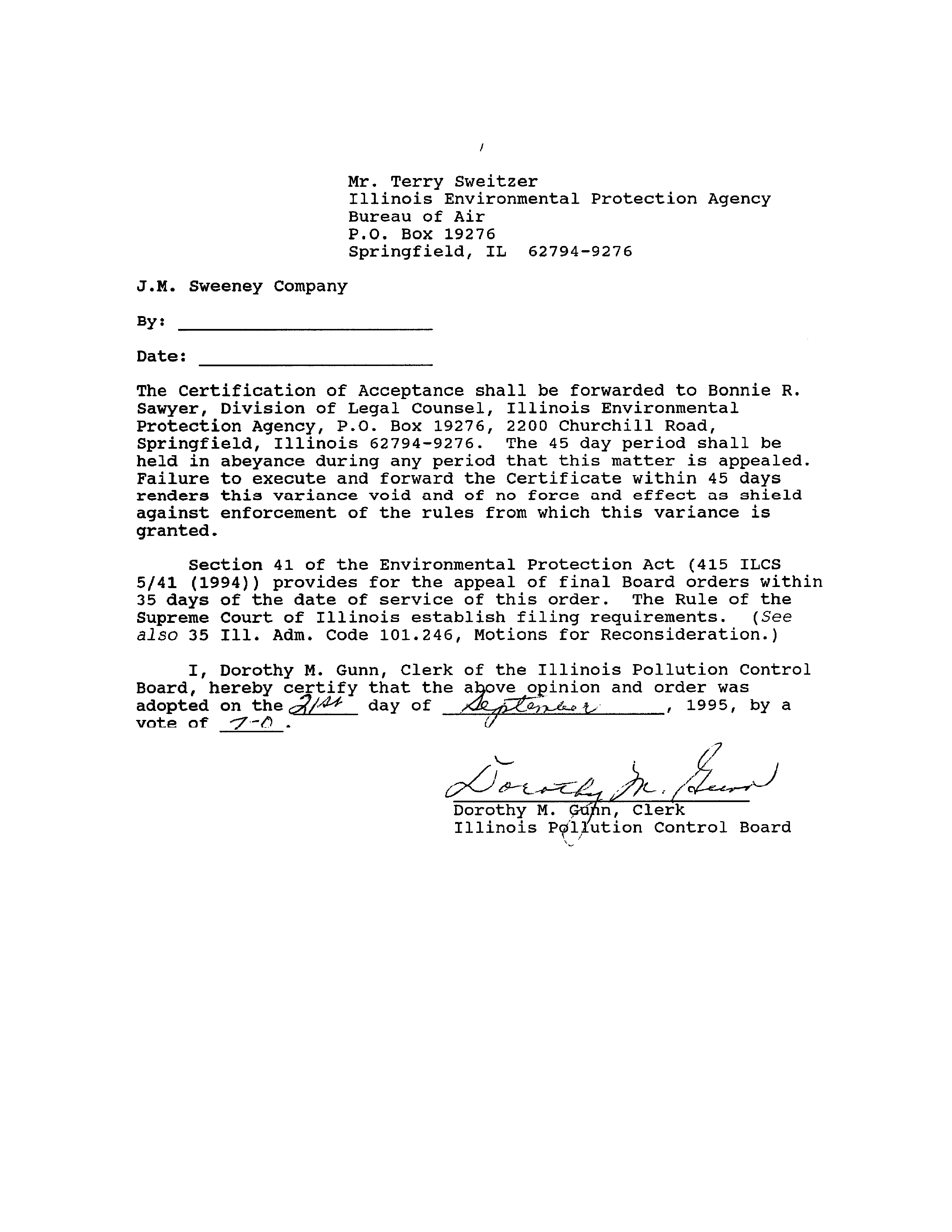£LL.LZ’IU.LS
.&UL~LUTiUtJ
CUIMiRUL
bUAiCL)
september 21,
1995
J.M. SWEENEY CO.,
)
)
Petitioner,
)
V.
)
PCB 94—297
)
(Variance-Air)
ILLINOIS ENVIRONMENTAL
)
PROTECTION AGENCY,
)
)
Respondent.
MR. DIRK C. MCELRAVEY OF BRYDGES, RISEBOROUGH, MORRIS, FRANKE
&
MILLER APPEARED ON BEHALF OF PETITIONER;
MS. BONNIE SAWYER OF THE ILLINOIS ENVIRONMENTAL PROTECTION AGENCY
APPEARED ON BEHALF OF RESPONDENT.
OPINION AND ORDER OF THE BOARD
(by C.
T.
Cirard):
On October
19,
1994,
J.M. Sweeney
(Sweeney)
filed a request
for a variance from the Board’s regulations which require
installation of Stage II Vapor Recovery Systems at retail
gasoline dispensing facilities.
(35 Ill.
Adm. Code 218.586.)
Sweeney seeks a variance to allow it to delay installing a Stage
II System until March
31,
1996.
On November 29,
1994,
the Illinois Environmental Protection
Agency (Agency)
filed its recommendation supporting the grant of
the variance with certain conditions.
Hearing was held before
Board hearing officer David Krause on June
1,
1995,
in Chicago,
Illinois.
No members of the public were present to testify on
the record.
The Board’s responsibility in this matter arises from the
Environmental Protection Act
(Act)
(415 ILCS 5/1 et seq.
(1994).)
The Board is charged in the Act with the responsibility of
granting variance from the Board regulations whenever it is found
that compliance with the regulations would impose an arbitrary or
unreasonable hardship upon the petitioner.
(415 ILCS 5/35(a).)
The Agency is required to appear in hearings on variance
petitions.
(415 ILCS 5/4(f).)
The Agency is also charged,
among
other matters, with the responsibility of investigating each
variance petition and making a recommendation to the Board as to
the disposition of the petition.
(415 ILCS 5/37(a).)
BACKGROUND
Petitioner operates a gasoline dispensing facility
at. 2454~
2
West Miller Road,
Lake Zurich,
Illinois.
(Pet. at
2.)’
Petitioner has operated the facility since prior to November 1~
1990, and employs ten people.
(Pet.
at
2;
Ag.
Rec.
at
3.)
In
January of 1994 petitioner performed tank tightness tests on the
underground storage tanks at the facility.
(Pet.
at
2.)
The
tanks tailed the tightness test and Protessional Tank Services,
LTD
(PTS) were retained to determine if a petroleum release had
occurred.
(Pet.
at
2.)
PTS determined that a leak had occurred
and petitioner notified the Illinois Emergency
Management Agency
of a release on January 20,
1994.
(Id.)
PTS performed a limited soil investigation on April
19 and
20,
1994.
(Pet.
at
2.)
Petitioner and PTS have concluded that
corrective action may be necessary to remediate petroleum
contamination at the Sweeney facility.
(Pet.
at
3.)
On
September 1,
1994, petitioner submitted a site characterization
work plan to the Agency.
(Pet.
at 3.)
At hearing
on June
20,
1995,
petitioner updated the status
of the investigation and remedial work at the site.
The
Septmeber work plan was approved by the Agency and implemented to
e1a~~i.fyth~sit~. Subs~qu~nt1y
on February 17,
1995,
a site
classification completion report was submitted by petitioner, as
well as a request for cost reimbursement for early action
activities.
Per the Agency’s request, additonal information
amending the 45 day report was also submitted early in 1995.
Petitioner has since been advised by the Agency that the site
classificaiton report has been selected for full review.
Therefore the Agency is to advise petitioner no later than June
17, 1995 if more information is required.
(Tr. at 10-11,
13.)
At hearing the Agency reported that the classification report
indicatQd that site’s classification
is most likely to be high,
meaning remediation will be necessary.
(Tr.
at
14.)
REGULATORY FRAMEWORK
Sweeney is seeking. a variance’s from the Board’s air
regulations as these regulations relate to installation of Stage
II vapor recovery equipment.
The regulations that Sweeney is
seeking a variance from are found at 35 Ill.
Adm. Code 218.586.
Section 218.586 is entitled Gasoline Dispensing Operations
-
Motor Vehicle Fueling Operations, which provides in pertinent
part that:
b)
The provisions
of subsection
(c) below shall apply to
any gasoline dispensing operation which dispenses an
‘The petition for variance will be cited as “Pet.
at
_“;
the Agency recommendation will be cited as
“Ag.
Rec.
at
_“;
the
transcript from the June
1 hearing will be cited as “Tr.
at
“.
average monthly volume of more than 10,000 gallons of
motor vehicle fuel per month.
Compliance shall be
demonstrated in accordance with the schedule provided
in subsection
(d) below.
d)
In conjunction with the compliance provisions of
Section 218.105
of this Part, operations subject to the
requirements of subsection
(c) above shall demonstrate
compliance according to the following:
~1)
Operations that commenced construction before
November 1,
1990,
and dispense an average monthly
volume of less than 100,000 gallons of motor fuel
per month must comply by November 1,
1994.
In determing whether
a variance
is to be granted, the Act
requires the Board to determine whether a petitioner has
presented adequate proof that immediate compliance with the Board
regulations at issue would impose an arbitrary or unreasonable
hardship.
(415 ILCS 5/35(a)
(1994).)
Furthermore,
the burden is
upon the petitioner
to show that its claimed hardship outweighs
the public interest in attaining compliance with regulations
designed to protect the public.
(Willowbrook Motel v. Pollution
Control Board,
(1985),
135 Ill. App.3d 343, 481 N.E.2d 1032.)
Only with such a showing can the claimed hardship rise to the
level of arbitrary or unr~asonab1ehardship.
A further feature of a variance is that it is,
by its
nature,
a temporary reprieve from compliance with the Board’s
regulations,
and compliance is to be sought regardless of the
hardship which the task of eventual compliance presents an
individual polluter.
(Monsanto Co.
v.
IPCB,
(1977),
67 I11.2d
276, 367 N.E.2d 684.)
Accordingly,
except in certain special
circumstances, a variance petitioner
is required,
as a condition
to grant of variance, to commit to
a plan which is reasonably
calculated to achieve compliance within the term of the variance.
COMPLIANCE PLAN AND HARDSHIP
Sweeney asserts that it has evaluated alternative methods
for compliance with the Stage
II requirements and that “no
interim measures can be implemented to achieve whole or
partial
compliance with these requirements”.
(Pet. at
3.)
sweeney
estimates that it will cost $80,000 to comply with the Board’s
regulations.
(Pet.
at
3.)
However,
Sweeney also believes that
if it were to timely install Stage
II vapor recovery
equipment,
‘1
Sweeney would be required to dismantle
the system in order to
perform corrective action
to remediate the petroleum release at
the site.
(Pet.
at 3.)
Sweeney estimates that the salvage value
of the components of a dismantled system would be between $20,000
and $30,000.
(Pet.
at 3.)
Sweeney asserts that it estimates it
would lose between $50,000 and $60,000 it sweeney were required
to install Stage II by November 1,
1994 and later dismantle the
system.
(Id.)
The Agency agrees that it would be a hardship for Sweeney to
comply with the Stage II
requirements
at this time considering
that the Stage II eguipment may need to be dismantled if
corrective action is required.
(Ag. Rec.
at
6.)
The Agency
states that “Sweeney will suffer an arbitrary and unreasonable
hardship should the Board not grant relief from the Stage II
requirements in Section 218.586”.
(Ag.
Rec.
at 7.)
However, the
Agency states that it “does not believe that the extent of relief
requested in Sweeney’s petition for variance is necessarily
needed”.
(Ag.
Rec.
at
7.)
The
Agency suggests
that
conditions
limiting the length of the variance,
if corrective action
is not
necessary,
should be attached to the granting of the variance.
ENVIRONMENTAL IMPACT
Sweeney estimates the uncontrolled emissions from its
facility are “approximately 1076.4 pounds of VOC per month”.
(Pet.
at 4.)
Sweeney refers to the Agency’s 1990 Chicago Ozone
SIP Inventory Summary which indicates that the total VON
emissions on a weekday during the ozone season is 1453.69 tons.
(Id.)
Sweeney states that its uncontrolled VON emissions “would
total approximately
.5 tons per day or approximately
.0034
percent of the total VOM emissions per day in the Chicago area”.
(Id.)
The Agency disagrees with Sweeney’s calculations of
Sweeney’s VON emissions and instead calculates daily emissions at
“about .02 tons per day” which would compromise approximately
.001 percent of the total VON emissions per day in the Chicago
area.
(Ag.
Rec.
at
5.)
The Agency concedes that the VON
emissions from this station “are not that significant when
compared to the total Chicago area VON emissions”.
(Ag.
Rec.
at
5.)
However, the Agency also notes that the ozone problem in
Chicago is “largely attributable to numerous smaller sources
that, when aggregated, add up to significant emissions”.
(Id.)
The Agency does recommend granting this variance however as
Sweeney is seeking relief from the Stage
II requirements to
mitigate potential damage to another “environmental medium”.
(Ag. Rec. at 5.)
The Agency theretore believes that the hardship
“Sweeney would incur if required to install the Stage
II
equipment by the November 1,
1994 deadline only to dismantle and
reinstall if remediation proves necessary,
outweighs the
5
environmental impact from allowing this facility to emit
uncontrolled VOMs for the variance period.”
(Ag. Rec.
at 5.)
CONCLUSION
Based on the record the Board finds that Sweeney has
established that compliance with
35 Iii.
Adni. Code 218.586
constitutes an arbitrary or unreasonable hardship.
Further, the
Board finds that the
environmental impact of
this
variance does
not pose a significant risk to environmental health due to the
temporary relief which is being granted.
The Board will grant
the variance with the conditions recommended by the Agency.
If
Sweeney is not required to perform corrective action which would
require the dismantling of the tank system, then Sweeney should
be able to comply with the Stage II vapor recovery system
requirements within a reasonable timeframe.
Therefore, the time
conditions suggested by the Agency will be adopted in the Board’s
order.
Sweeney has requested that the variance commence on November
1, 1994 and end on March
31,
1996.
The Board notes that it is
well established practice that the term of a variance begins on
the date the Board renders its decision, unless unusual or
extraordinary circumstances are shown.
~
DM1,
Inc.
v.
IEPA,
PCB 90—227,
128 PCB 245—249,
December 19,
1991.)
In view of the
facts of this case,
the Board will grant the variance from
November 1,
1994.
This opinion constitutes the Board findings of fact and
conclusions of law in this matter.
ORflE1~
The Board hereby grants this variance, commencing
retroactively from November 1,
1994,
to J.M. Sweeney,
Co. for the
facility at 24545 West Miller Road,
Lake Zurich,
Illinois,
subject to the following conditions:
1.
If the site classification concludes that no further
remediation is necessary,
Sweeney will complete
installation of Stage II equipment within 45 days of
the Agency’s concurrence with this conclusion.
2.
If the site is classified as low priority, Sweeney will
complete installation of Stage
II equipment within
45
days of the Agency’s concurrence with this
classification.
3.
It remediation
is required but the
method selected will
not interfere with Stage II equipment,
Sweeney will
install Stage II equipment within 45
days of approval
of this method.
6
4.
If the site is classified, and requires further
remediation,
Sweeney will install Stage II equipment
within 45 days of completion of remediation, but in no
case later than March
31,
1996.
5.
Sweeney shall notify Terry Sweitzer or the Agency as to
classification of this site within
14 days of receipt
of site classification approval.
Such notice shall be
sent to:
Mr. Terry Sweitzer
Illinois Environmental Protection Agency
Bureau of Air
P.O. Box 19276
Springfield,
IL
62794—9276
6.
Sweeney shall notify the Agency of the installation of
any Stage II equipment within 14 days after its
installation.
Notification
shall include the address
of the facility and shall be sent to Terry Sweitzer at
the address provided in
“E” above.
IT IS SO ORDERED.
Within 45 days of any Final Board Order granting the
variance, Sweeney shall certify in writing that it accepts and
agrees to be bound to all terms and conditions of the granted
variance, and such certification shall be in the form as follows:
CERTIFICATION
Sweeney, hereby accepts and agrees to be bound by all terms
and conditions of Order of the Pollution Control Board in PCB 94-
297,
including the following conditions:
1)
Sweeney will close this station by April
1,
1995,
and
it will not be reopened to dispense gasoline until
Stage II vapor recovery systems are operational.
2)
In the event that Sweeney is unable to pursue the
reconstruction plans outlined in its Petition, Stage II
vapor recovery equipment shall be installed within
30
days of the abandonment of reconstruction plans.
3)
Sweeney shall notify the Agency of the installation of
any Stage II equipment within 14 days after its
installation.
Notification shall include the address
of the facility.
Such notice to the Agency shall be
sent to:
Mr. Terry Sweitzer
Illinois Environmental Protection Agency
Bureau of Air
P.O. Box 19276
Springfield,
IL
62794—9276
J.N. Sweeney Company
By:
_______________________
Date: ______________________
The Certification of Acceptance
shall be forwarded to Bonnie R.
Sawyer,
Division of Legal Counsel, Illinois Environmental
Protection Agency,
P.O.
Box 19276, 2200 Churchill Road,
Springfield,
Illinois 62794—9276.
The 45 day period shall be
held in abeyance during any period that this matter is appealed.
Failure to execute and forward the Certificate within 45 days
renders this variance
void
and
of
no force
and
effect
as shield
against enforcement of the rules from which this variance is
granted.
Section 41 of the Environmental Protection Act
(415 ILCS
5/41
(1994)) provides for the appeal of final Board orders within
35 days of the date of service of this order.
The Rule of the
Supreme Court of Illinois establish filing requirements.
(See
also
35 Ill. Adm. Code 101.246, Motions for Reconsideration.)
I, Dorothy N.
Gunn,
Clerk of the Illinois Pollution Control
Board, hereby certify that the above opinion and order was
adopted on the~/4~ day of
,dc.&~
,
1995,
by
a
voteof
-7-~O.
(I
(7~J
Dorothy N.
at/in, Clerk
Illinois Pcfliution Control Board
